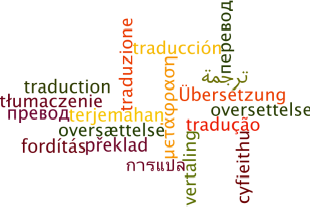Using translation

Using translation in the English language classroom has been
given a rather bad press in the last 30 years or so.
Previously, of course, when grammar-translation methods of one kind
or another dominated, the idea of translation from and into the
learners' mother tongue was not controversial at all.
The advent of communicative approaches to teaching languages
resulted in an almost immediate sweeping condemnation of translation
in the classroom.
What are the arguments?
 |
Against translation |
Carreres (2006) suggests the following arguments against using translation are the most prevalent:
- Translation is an artificial, stilted exercise that has no place in a communicative methodology. Also, it is restrictive in that it confines language practice to two skills only (reading and writing).
- Translation into L2 is counterproductive in that it forces learners to view the foreign language always through the prism of their mother tongue; this causes interferences and a dependence on L1 that inhibits free expression in L2.
- Translation into L2 is a wholly purposeless exercise that has no application in the real world, since translators normally operate into and not out of their mother tongue.
- Translation and translation into L2 in particular are frustrating and de-motivating exercises in that the student can never attain the level of accuracy or stylistic polish of the version presented to them by their teacher. It seems an exercise designed to elicit mistakes, rather than accurate use of language.
- Translation is a method that may well work with literary-oriented learners who enjoy probing the intricacies of grammar and lexis, but it is unsuited to the average learner.
To this list may be added two products of the rise of (especially English) language learning courses overseas in cultures where the target language is generally spoken.
- In these settings, for example, in Britain, Australia, the USA etc., groups of learners typically contain a range of first languages and this makes it very cumbersome or impractical to take the learners' first languages into consideration. There are too many of them, some students may be the sole representative of their languages in the classroom and the teacher cannot be expected to have mastered all the languages present.
- Teachers in these settings are frequently native speakers of English who do not speak the languages of their students (even when teaching mono-lingual groups) and therefore feel uncomfortable or are not competent when handling translation in either direction. Even outside English-speaking cultures, teachers are often native speakers of English for whom the same considerations apply. This is especially, but not solely, the case in the private sector.
 |
For translation |
translation develops three qualities essential to all
language learning: accuracy, clarity and flexibility. It
trains the learner to search (flexibility) for the most appropriate
words (accuracy) to convey what is meant (clarity).
(Duff 1994;160)
There is a range of counter arguments, too, including the assertion that it is not the use of translation that is poor practice but that the ways in which it has been used represent poor practice:
- Translation happens all the time so why not make use of it in the classroom? Even sophisticated learners of languages (such as language teachers?) will deploy translating dictionaries on their travels (however much they may admonish their learners to use monolingual dictionaries in the classroom).
- Machine-powered translation programs are now available on even cheap and unsophisticated devices and are unlikely to become less prevalent. Dealing with the output from these programs requires a certain level of translation expertise to make sense of the product. For example, translating even a simple sentences via a smart phone may produce something almost incomprehensible to a native speaker as anyone who has done it can testify.
- Some research suggests that language learners find translation exercises useful and motivating (Carreres, op cit.).
- Translation into L2 can be a very useful tool in terms of getting learners to notice differences in form between languages and to gain formal competence in constructing acceptably grammatical utterances. Once formal accuracy has been achieved, the language can be practised and used in communicative exercises so the two approaches are complementary, not mutually exclusive.
- Translation can often reduce the strain on learners' memories because simple one-to-one translations of lexemes, phrases and whole idioms are often possible. Trying to remember that the term ferret in English refers to a domesticated polecat used for catching rabbits is arguably more difficult than remembering that the Spanish word is hurón, the German is das Frettchen and so on. From there, it a shorter step to remembering that fureter in French means to ferret about in the sense of search for in English.
- Translation can often reduce learner anxiety in terms of being sure that they have understood something clearly and have really grasped the meaning of individual language items. The alternative is often the use of extended, time-consuming (and often inaccurate) concept-checking routines.
 |
L1 → L2 or L2 → L1? |
It is often asserted that translating from one's first language into a second language is:
- very difficult because it demands very high second-language skills
- a pointless exercise because it is rarely done in the real world
- demotivating because the result is rarely at the level of sophistication that the learner hopes to achieve
- too demanding for teachers whose first language is not English
In fact:
- it needn't be difficult if the task is realistic
- it is often done in the real world, especially in professional settings in which the writer / speaker has a particular term in mind that needs to be rendered in a second language
- it is motivating and seen as valuable for many learners when they get it right
- it is often the only way in which a native-English-speaking teacher can judge whether the translation is successful
Translating from English into one's first language has also been criticised because:
- it forces learners to view the foreign language always through the prism of their mother tongue (Carreres, above)
- it slows down production because the learner is going through a complex cognitive process between meaning and language (starting with meaning, encoding it in L1, re-encoding it in L2 and then producing it, rather than encoding meaning directly into L2)
- unless the teacher is a very competent speaker of the learners' first language(s), it is impossible for her/him to know whether the translation is accurate
In fact:
- viewing L2 by making comparisons with how things work differently in L1 (and vice versa) is a valuable noticing exercise that can facilitate learning
- taking time carefully to consider the best way to express a thought in L2 is rarely time wasted but simply jumping in and deploying language in L2 that is 'good enough' is often imprecise and ineffective
- most teachers of English worldwide are not native speakers of the language and most of them will be masters of their learners' first languages so it is easy for them to judge the success of a translation exercise
 |
Translating the untranslatable |
| Waldeinsamkeit |
Non-specialists will often state that some words in their first languages cannot be translated into another language. They are, of course wrong. Here is a selection of words that out here on the internet people have stated are untranslatable into English:
| Language | Word | Meaning |
| German | Waldeinsamkeit | the feeling of solitude in the woods |
| verschlimmbessern | to make something worse when attempting to improve it | |
| Japanese | age-otori | looking worse after a bad haircut |
| boketto | gazing vacantly into the distance | |
| Swedish | mångata | the wavy, road-like reflection of the moon on water |
| gökotta | wake up early to go outside to hear the first birds sing | |
| Spanish | sobremesa | a long post-lunch socialising event |
| tuerto | a man with only one eye | |
| French | esprit de l’escalier | thinking of the perfect thing to say too late |
| flâner | aimlessly wandering the streets of Paris to soak up the atmosphere | |
| Russian | listopad | the falling of the leaves |
| pochemuchka | a person who asks too many questions | |
| Greek | filotimo | an exaggerated feeling of dignity, honor and responsibility |
| xerosfyri | consumption of alcohol without accompanying food |
And the list can go on. Responses to the website from which
some of the above were taken (https://www.global-lingo.com/untranslatable-words-ultimate-list/)
include comments that many of these words may not have a one-word
equivalent in English but they do in other languages. The
French esprit de l’escalier, for example, has a direct
equivalent in German: der Treppenwitz [the staircase
witticism].
Unfortunately, neither the responses nor the site mentions that it
is nonsense to call them 'untranslatable'. As the list above
shows, the meanings can be expressed perfectly well in English and,
in fact, in all
other languages. Nothing is untranslatable but many words in
many languages have no one-to-one equivalent in other languages.
That is certainly not the same thing as saying that they are
untranslatable.
To aver that a word in a language is untranslatable is to suggest
that speakers of that language have an exclusive use of a concept
or behaviour which nobody else can imagine. In other words, the assumption
is that the speakers of that language are, in this respect, superior
to the poor foreigners who do not happen to have a word for it.
This has been referred to as cultural fascism. More kindly, it
can be described as a self-serving delusion.
It is, by the same token, however, clearly true that language is
culturally determined and what is important, noteworthy, usual or significant
within a culture will probably be encoded in a single word.
That's interesting and sometimes revealing but does not make
speakers of that language unique in some mysterious way.
 |
Connotation is a different matter ... |
| Stubborn am I? |
Connotation refers to the idea or feeling that a word evokes in
addition to its basic meaning (or denotation).
While everything is translatable, some meanings of words do not
travel well. For example, words which are seen as negative or
particularly positive in one language may not carry that impression
even when a one-word translation is available. For example, in
English the word reasonable is a very positive way to
describe socially acceptable and generally sensible behaviour.
Other languages will have a one-word translation but in many, the
word will carry no such connotation of gentle, unassertive,
non-confrontational behaviour.
Connotational phenomena are also relevant to verbs so, for
example, the English word grin has a cognate in German (grinsen)
which, however, carries a sense of insincerity lacking from the
English verb although they both denote the same action.
In many languages, too, certain adjectives carry positive or
negative connotations and when they are translated, the connotations
may be unpredictable. In English, the adjectives cheap,
stubborn, childish and skinny, for example, are
generally less positive than their near synonyms, inexpensive,
determined, childlike and slim / slender but that is
certainly not a universal phenomenon and the translations of the
words into other languages will usually lose the connotations they
carry in English. That works in reverse, too, naturally.
Languages connote differently concerning nouns
for certain animals. For example, in English comparing someone
to a magpie is seen as derogatory (in the sense of a disorderly
collector) but in China the bird is seen as auspicious
and the bringer of good news.
 |
... and so is semantic space |
Words have meaning when the speech community within which they
are used agrees, more or less, on their semantic space. That
is to say, where they fit into the reality of the world around the
speakers.
So, for example, if someone in English were to say,
What's the name of that bush?
there is a strong likelihood that the hearer will immediately be
alerted to to look for a plant no smaller than, say one metre tall
and no higher than two. The height parameter is a key
isolating characteristic of a bush which makes it different from a
tree or a plant.
That it will be green, have leaves and a trunk of some kind are also
parts of its unique semantic space. It will not be very low to
the ground or very tall and will not be made of anything but natural
substances. That may not be the case in all languages.
It is reasonably obvious to most people that many things that people
deal with, ideas that they have, things they do and so are universal
in all languages but that is not a given.
Most languages, have, for example, a verb meaning go as in:
I'm going to the market
but how that is encoded may vary considerably. In some
languages, the verb will inevitably imply walk in others it
will not, for example. In some languages, the verb may be
combined with the noun and form a compound of sorts which means
something like shopping in market and so on.
It is unwise to assume that translation will cope with the concept
of semantic space very effectively.
 |
Translation in the classroom |
The activities you choose to do in the classroom which may use some translation will often depend on:
- your first language(s) / your ability in your students' first language(s). If you have adequate mastery of your learners' first language(s) as well as English, you can use translation both into and out of English
- the make up of your class(es). If you are teaching multi-lingual groups, only translation into English is likely to be a practical proposition
 |
Signs and notices |
Signs and notices are a rich source of translation exercises
because they often require very precise and unambiguous language.
We have all seen the results when it goes wrong so a collection of
signs in imperfect English can also stimulate learners to correct
the language to get it right. An internet image search for
'wrong English signs' will provide enough examples to keep you
supplied for a good while.
In addition, the exercise of translating signs into and out of the
learners' first language(s) can act well to alert them to levels of
advice, admonition, permissibility, prohibition and obligation (all
to do with deontic modality) and how these are expressed.
 |
Proverbs and idioms |
| looking for a needle in a haystack |
Idiomatic or formulaic language is another rich source of
stimuli for translation.
Getting learners to bring in favourite idioms in their own languages
and render them in English to their classmates can educate and
amuse. Some, such as the example above, will translate into
many languages exactly but others require a good deal of rephrasing
in English to be comprehensible. For example:
| In ... | the idiom ... | is in English ... |
| Czech | to walk around hot porridge | to beat about the bush |
| Dutch | to polar bear | to pace around |
| French | to have long teeth | to have your sights set high |
| German | don't praise the day before the evening | don't count your chickens until they are hatched |
| Japanese | to look at with long eyes | not crossing bridges till you come to them |
| Russian | to smear eyeglasses | to pull the wool over someone's eyes |
and so on.
Your learners can come up with many more, of course.
 |
Cognates |
Languages which share roots, such as almost all those indigenous to Europe, will often have recognisable cognate words in common. There is a guide to cognates and false friends on this site from which the following examples are taken.
| English | Spanish | Italian | French | Portuguese | Romanian |
| administer | administrar | amministrare | administrer | administrar | administra |
| operation | operación | operazione | opération | operação | operație |
| expression | expresión | espressione | expression | expressão | expresie |
| communication | comunicación | comunicazione | communication | comunicação | comunicare |
These are not false friends but real cognates whose
meaning is nearly identical in all the languages.
Some work on translating cognates between the learners' first
languages and English can help them to notice that the differences
are not random and allow some intelligent guessing that, for
example, a word ending in -ción in Spanish is likely to
have a cognate in English ending in -tion and so on.
There is, of course a need to alert learners to false friends as
well (such as the well known sensible-sensitive problem)
and this, too, can be achieved by reference to the learners' first
language. It is worth remembering, however, that true cognates
outnumber false friends by a very considerable amount. In
other words, they serve to facilitate learning very much more
frequently than they inhibit it.
 |
Focusing on word order and syntax |
Languages differ. This will come as no surprise, of course,
but one of the most powerful aspects of using translation in the
classroom is to alert people (i.e., get them to notice) just how
their first languages differ from English especially in terms of
word order and syntax. There are two guides on this site, both
linked in the list of related guides at the end, which
will give you some ideas about how to approach this area via
translation tasks:
Subjects and
objects focuses on identifying the ordering of the essentials of
the sentence.
Types of languages
takes a wider view of the differences between languages and how they
signal grammatical function.
One obvious way forward in this area, especially, but by no means
solely, useful for lower-level learners is to compare direct,
word-for-word translations with a corrected English sentence or
phrase. For example,
| In ... | ... the sentence is ... | ... and the direct translation is ... | ... but in English should be ... |
| Turkish | Hasan öküzü aldı | Hasan ox (+accusative) bought | Hasan bought the ox |
| Malagasy | Nahita ny mpianatra ny vehivavy | Saw the student the woman | the woman saw the student |
| Greek | Όλοι έφεραν τα διαβατήριά τους | All brought the passports their | They all brought their passports |
| French | Elle l'a vu et sa peinture étonnante | She he has seen and his painting astonishing | She saw him and his astonishing painting |
One obvious target of exercises like this is the distinction between
languages, such as English, French, Portuguese, Russian etc. in
which the normal word order is Subject - Verb - Object and languages
such as Japanese, Korean, Turkish and Tamil in which the normal word
order is Subject - Object - Verb.
Languages which use post positions rather than prepositions or those
which routinely put the adjective after the noun are also suitable
targets for a little one-to-one translation and comparative work in
the classroom.
 |
Polishing machine translations |
Machine translations are ubiquitous and improving all the time
but they still produce translations which are, to a native speaker,
poorly expressed. A useful exercise is to start with a text
translated from the learners' first language into English by a
machine or website facility and then to polish it until it is in
acceptable English. Almost any text will do but it should be
something at the learners' level or the exercise can become
disheartening.
The first sentence of this paragraph has been translated into and
out of French by Google translate. The result is:
Automatic translations are omnipresent and improve all the time but continue to produce translations of which they are, to a native speaker, poorly expressed.
Clearly, that is still comprehensible but needs to be altered to make it sound like natural English.
 |
Chain translations |
A similar exercise, which can be done without computer access, is
to start with a short text in English. This is given to the
first pair to translate it
into the class's mother tongue who then pass it on to the next pair who
translate it back into English and so on. To keep everyone
occupied, a separate text can be used to start the process from the
other end of the queue.
A comparison of the end product with the original text can be
extremely informative and show the learners just where natural
expression in English differs from expression in their first
language(s).
This can, of course, be done with a short spoken text, too, in which case, the activity involves individual learners whispering their translation to the next learner and so on. The product at the end is often unrecognisable from the original text and a good deal of useful and educational discussion can be premised on why that should be and what went 'wrong'.
 |
Learner research |
With classes in English for specific purposes in particular, getting learners to do their own research into how particular technical or business-related terms are best rendered in English can encourage autonomy and provide a valuable learning experience for groups who then report back to the class as a whole.
 |
Oral translation work |
Apart from chain translations (see above), there is no reason why translation exercises need to focus on written texts. One of the reasons that translation has suffered from its poor reputation is that it was overly focused on writing and reading at the expense of speaking and listening. Here are a few suggestions (some from Heltai, 1989):
- Read a short text to the class in their first language and then get the learners, in pairs or as individuals, to see if they can come up with an oral summary of the main points in English. This can be preceded by a few comprehension questions in English to make sure there is some delay between hearing the text in L1 and summarising it in English. It is the gist of the text that is the target of the exercise, not a word-for-word or exact translation.
- Learners listen to or watch a dialogue between two characters in their L1. In English, they then discuss the attitudes, opinions and wishes of the speakers and then re-construct the dialogue in English.
- Learners are asked to read or listen to a news report in their L1 and to prepare a rough oral summary of the main points of the report in English. This they then deliver to the class as a whole (or to groups within it), discussing, as they go along, whether there were any special terms which they found difficult to render in English. This can lead to group self-help and dictionary work to refine and polish their ability to summarise the events in English.
- A similar activity can also be done in classes focused on English for Specific Purposes but in this case, the learners read a first-language text at home (it should be something related to the area of specialism) and then give a short summary, in English, of what they have read. The object is to alert the learners to gaps in their specialist lexical range. It does that well.
| Related guides | |
| subjects and objects | for the simple guide to getting the difference clear |
| types of languages | for a view of the differences between languages and how they signal grammatical function |
| cognates and false friends | for a guide to a clearly related area |
| interference and facilitation | for the guide to how learners' first or other languages may influence their learning of English (positively or negatively) |
| noticing | for a guide to an important learning strategy sometimes enhanced by translation |
| inferencing | for more on a related and important learning skill |
References:
Carreres, A., 2006, Strange
bedfellows: Translation and Language teaching The teaching of
translation into L2 in modern languages degrees; uses and
limitations, Available from: http://www.cttic.org/ACTI/2006/papers/Carreres.pdf
[retrieved 17/12/2016]
Comrie, B, 1989, Language Universals and Linguistic Typology, 2nd
edition, Oxford: Blackwell Publishers
Duff, A., 1994, Translation, Oxford : Oxford University
Press
Heltai, P, 1989, Teaching vocabulary by oral translation, ELT
Journal Volume 43/4 October 1989, Oxford: Oxford University Press
